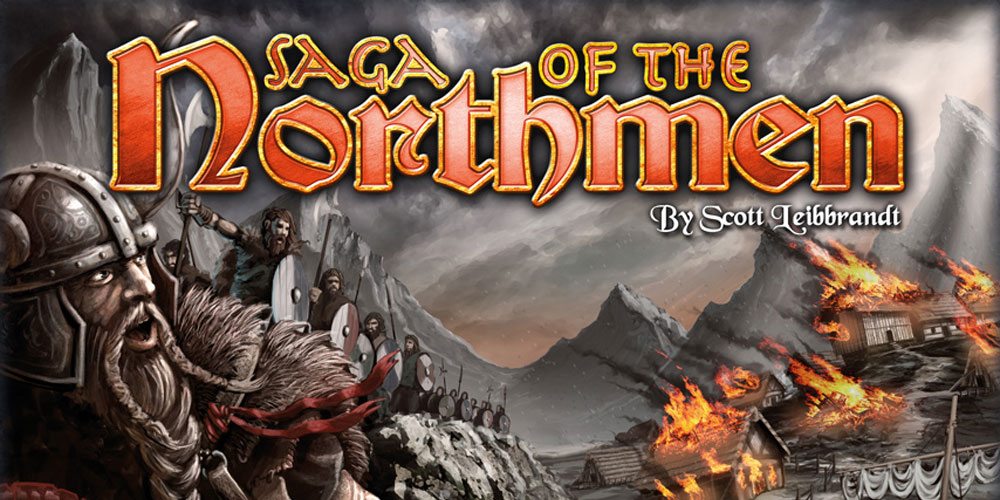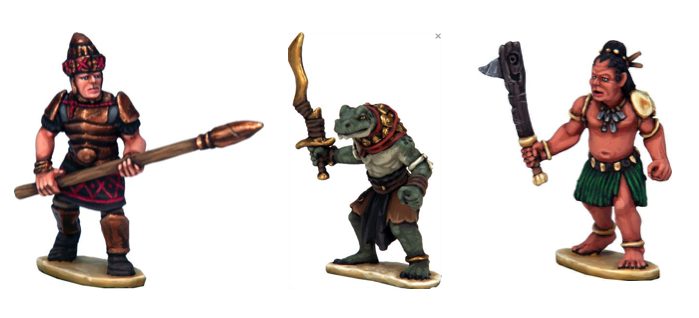In “Reaping the Rewards,” I take a look at the finished product from a crowdfunding campaign. Today’s title: Saga of the Northmen, which was funded in October 2016 and delivered to backers in March 2017.
At a glance: Saga of the Northmen is an area-control game for 2 to 4 players, ages 12 and up, and takes 30–40 minutes to play. It’s now available in game stores, directly from Minion Games, and from Amazon, and retails for $39.99. I think the game’s rules are simple enough that an experienced 10-year-old could probably learn it. The theme, of course, is about war and pillaging, which may not be as kid-friendly, though the game is fairly abstract and bloodless.
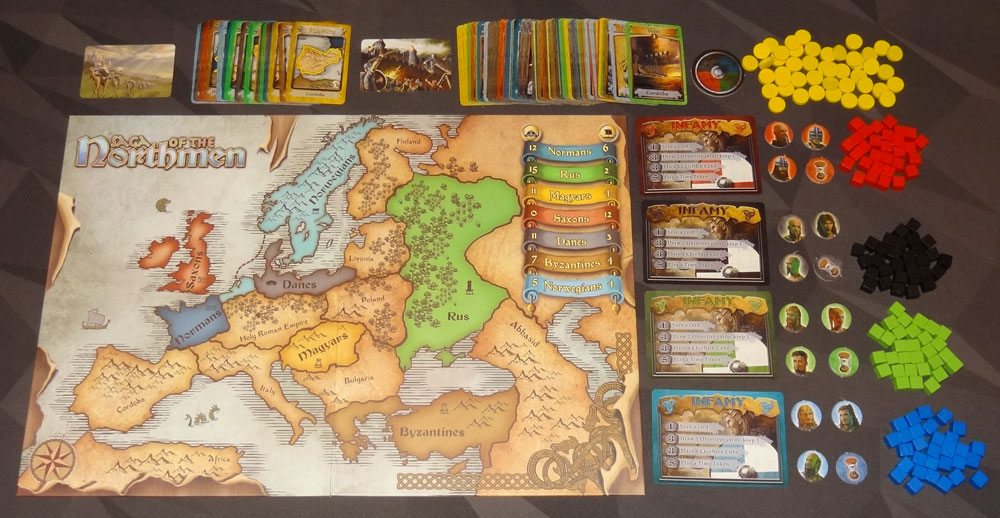
Components
- Gameboard
- 4 sets of player pieces, each containing:
- 1 Infamy card
- 3 Hero tokens
- 1 Time token
- 30 Influence cubes
- 56 Influence cards
- 20 Trade Route cards
- 45 Plunder tokens
- Leader token
The gameboard is a bi-fold board that looks like a map of Europe. The various kingdoms are color-coded and labeled with the names of the people: Danes, Magyars, Saxons, and so on; the neutral regions are all tan-colored and labeled with the names of the territory: Italy, Cordoba, Africa, etc. The board is nice overall, but my only complaint was that there’s a little separate piece of Norway that’s connected to the Holy Roman Empire, and it’s easy to overlook.
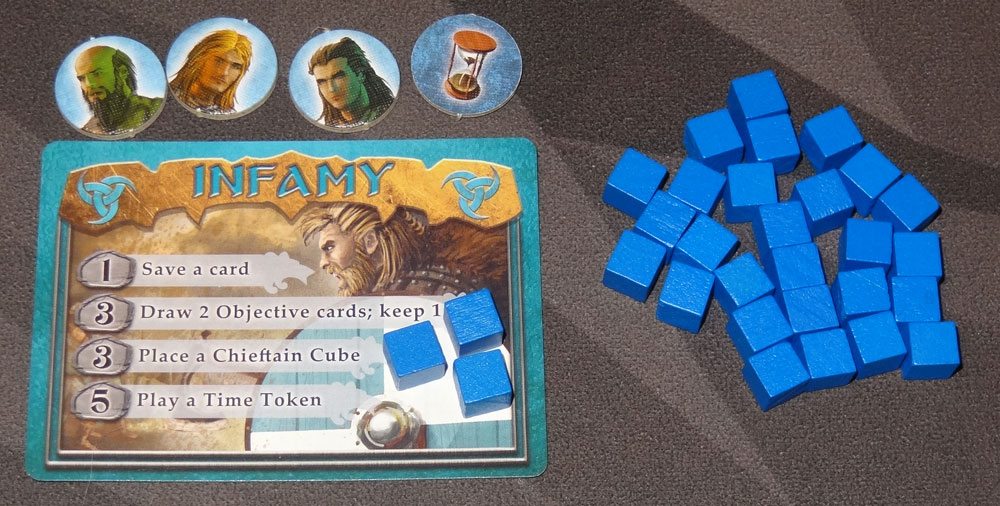
The Infamy cards have a small reference just for how you spend infamy points, and you store cubes on the card to count them as infamy. The other cards—influence and trade route—are mini cards, which I’m not a huge fan of because they’re harder to shuffle and handle. Generally, though, there’s not a ton of information on each card so having larger cards isn’t necessary for legibility. I do wish that the trade route cards were a different size, though, because I’ve had players try to use them as influence cards even though the artwork and layout isn’t the same.
The illustrations on the influence cards depict either armies (people) or ships from the various kingdoms, and I like that the warriors look different from each other, though some of the people look a little off, like the way 3D characters in video games sometimes look a little awkward. The ships look great, though.
Overall, though, the components are good quality and are fairly easy to use.
How to Play
The rulebook is available to download here.
The goal of the game is to score the most points by collecting plunder and completing trade routes over three rounds of play.
To set up, give each player all of the player pieces of their color: infamy card, influence cubes, hero tokens, and time token. Shuffle the influence cards and deal 6 to each player, and then place 3 cards face-up on the table next to the deck. Shuffle the trade route cards and deal 2 to each player. Divide the plunder tokens into sets of 15—you will use one set per round of play. Give the youngest player the leader token. Players will receive infamy based on the player count—you place cubes onto your infamy card to track how much infamy you have.
Each round has three phases: Rally, Marching, and Planning.
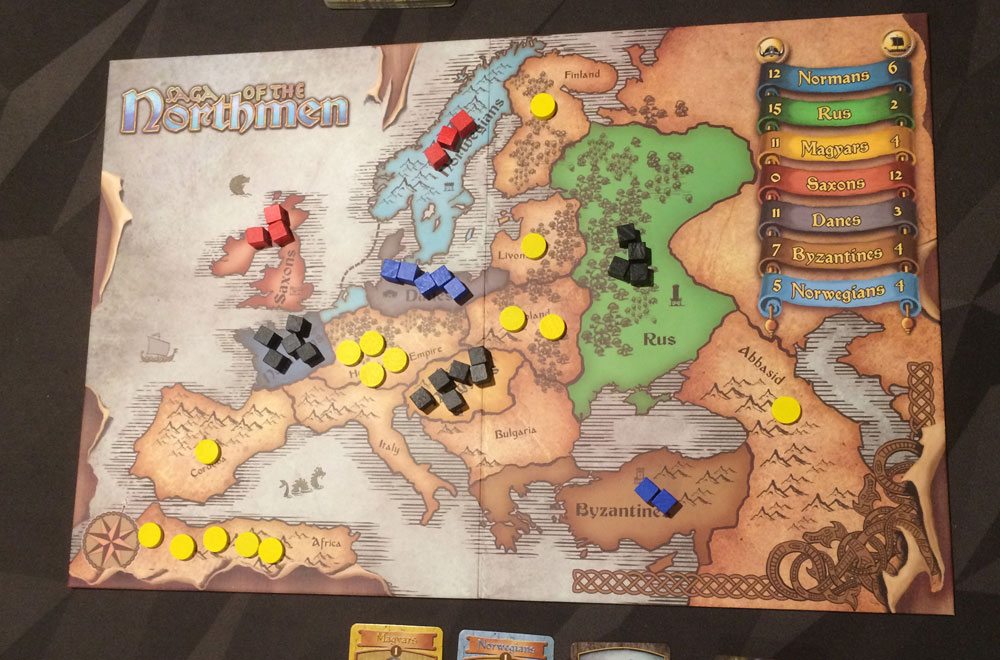
During the Rally phase, players compete for control of the seven kingdoms. Starting with the leader, players take turns playing influence cards from their hand. Most of the cards have the name of a kingdom and a number: you place that number of your cubes onto that kingdom on the map. If there is a neutral region listed at the bottom of the card, you place a plunder token from the supply onto that region. (There are icons indicating whether to skip the plunder in a 3- or 4-player game.) You may also optionally hire a hero by spending 3 infamy points to place one of your hero tokens into the region you just influenced. Then you draw an influence card, either from the 3 face-up cards or from the deck.
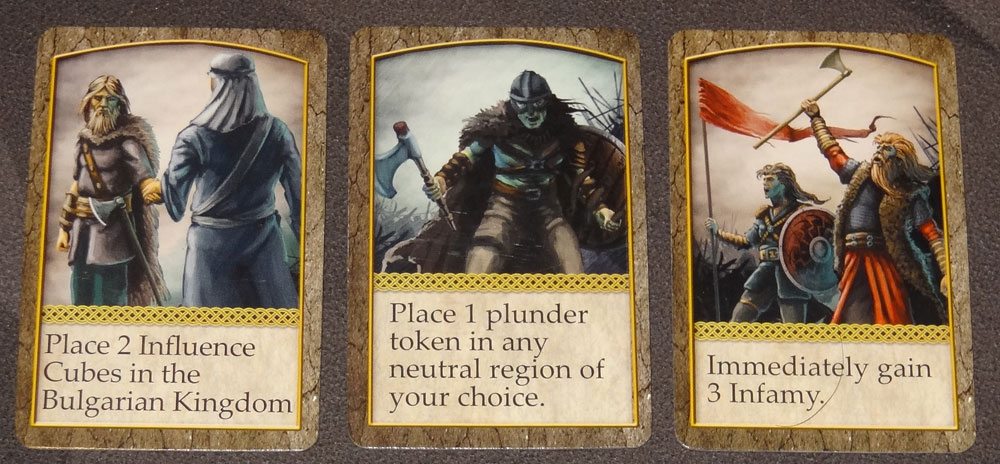
Some influence cards have other effects, such as adding plunder or influence into a neutral region of your choice. All influence cards are played face up in a stack in front of you, so that each player has their own stack. You may look through your own stack but not those of other players.
As soon as all 15 plunder tokens have been placed, the Rally phase ends.

During the Marching phase, players will use their kingdoms to take over neutral regions, getting plunder and completing trade routes. First, you check to see who controls each kingdom: whoever has the highest number of cubes and hero tokens wins, with ties broken by number of hero tokens, and then closest clockwise from the player with the leader token. If you don’t win a kingdom, you remove all of your pieces from it, placing cubes on your infamy card and hero tokens back in your supply.
Then, in the order shown on the board, players move their cubes and heroes out from the kingdoms. You may spend 5 infamy to play your time token—you place it on the banner for the corresponding kingdom, which then skips its turn for now. After all 7 kingdoms have had a turn, you come back to the ones with time tokens and resolve them in order.

When it’s your turn to move a kingdom, you reveal all of the cards you played for that kingdom, showing how many armies and how many ships you have. Soldiers may move to adjacent neutral regions, and ships may move to any neutral region that is adjacent to the sea (i.e., any region except the Holy Roman Empire and Poland, which are both landlocked). Hero tokens may be moved as soldiers or ships.
Once all of the kingdoms have been resolved, check each neutral region to see who won—again, with ties broken by number of hero tokens and then clockwise from the leader token. All losing cubes go to infamy, and losing hero tokens are placed back in the player’s supply. If you control a region, you collect all plunder tokens from that region.
Then, check if you have completed any of your trade routes: you must have controlled the kingdom at the top of the card and the neutral region shown at the bottom of the card. If so, you place the trade route face up on the table to indicate you have completed it. Once everyone has collected plunder and played trade route cards, remove all the cubes and tokens from the board and place them back in your supply.
During the Planning phase, you set up for the next round. Starting with the leader, players may spend infamy points to get new trade routes or to keep influence cards. Spend 3 infamy to draw 2 trade route cards and keep one of them. Spend 1 influence to keep an influence card for the next round. You may do either of these actions as many times as you can afford it. Any remaining influence cards are discarded.
All discarded influence cards are shuffled back into the deck, the leader token is passed to the left, and then the next round begins.
The game ends after the third round (skipping the Planning phase). You score 1 point per plunder and points shown on the completed trade route cards. The player(s) with the most unused infamy points also gets an additional 1 point per completed trade route. Highest score wins, with ties broken by the most unused infamy points.
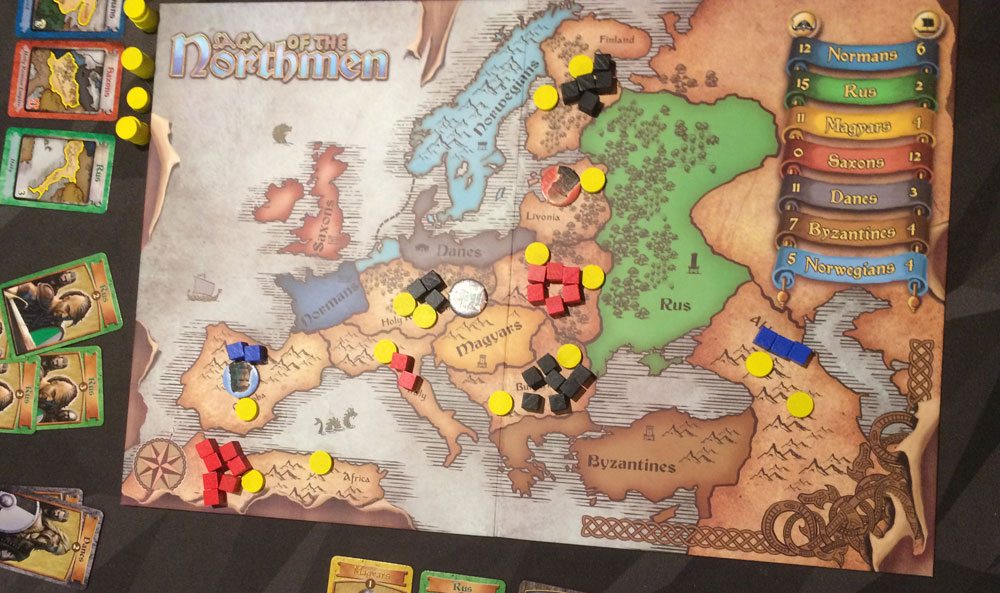
The Verdict
I missed the Kickstarter campaign for Saga of the Northmen, but I was glad to get a review copy from Minion Games to try out. It’s an interesting take on territory control because of the two primary phases of the game.
During the Rally phase, you are trying to influence the various kingdoms: Danes, Normans, Byzantines, and so on. The player with the most influence controls that kingdom, but the losers gain infamy, which can also be pretty useful. Then, in the Marching phase, you use all of those armies and fleets to take over neutral regions, both for plunder and to complete trade routes. Where things get tricky is that to complete a trade route, you have to win control in both phases: a specific kingdom paired with a specific neutral region—but you might not be using the armies and fleets from that kingdom to take over that region.
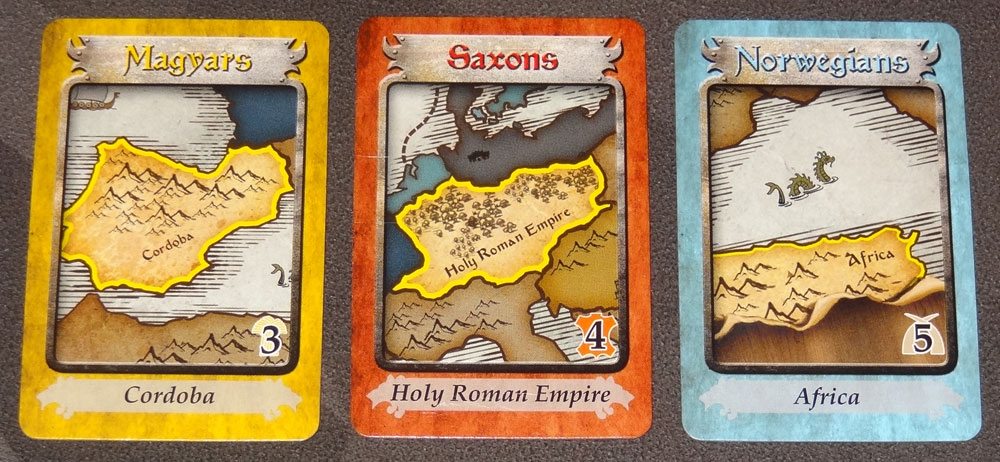
For instance, the Norwegians only have 4 ships total, but you can only get to Africa by boat. So if you wanted the 5-point trade route pictured above, not only would you need to control the Norwegians at the end of the Rally phase, you will probably need to invest in some ships elsewhere to help you get to Africa. Likewise, the 4-point trade route shows the Saxons (who only have ships) and the Holy Roman Empire (which is landbound). You will not be able to take over the Holy Roman Empire with the Saxons at all, so you’ll have to invest in some armies adjacent to it. Depending on what everyone is fighting over, sometimes it’s best to abandon your trade route plans and instead just go after plunder, which can also be quite lucrative.
The order that the kingdoms resolve during the Marching phase is fixed, as shown on the board, and you can also see how many armies and fleets each kingdom might have. So if somebody has control of the Rus, you know it’s unlikely that they’ll have a lot of ships, but unless you remembered which cards they played during the Rally phase, you don’t know exactly how many. Generally, the larger kingdoms act first, giving the weaker kingdoms a little bit of an advantage because they won’t waste troops in a fight they can’t possibly win. However, the time tokens can be very powerful when used at the right time. You spend 5 infamy, and it delays your kingdom’s march, so then you can see what other people are doing before you commit your troops. This can be particularly effective if you have a large kingdom that activates early on.
The gameplay itself isn’t too difficult to learn, though the two-phase control can be a little confusing at first: some players try to march from one kingdom to another kingdom (rather than the neutral regions), but it doesn’t work that way. Once you get the hang of it, though, it makes for some interesting battles for control, both in the Rally phase and the Marching phase. When playing influence cards, not only do you have to decide where to put your troops (and how many), but also where the card will add plunder. The more cards that add plunder, the quicker the round will go, so players have a little bit of control over how long the Rally phase will last. If you want to squeeze a few more turns out of it, then play cards that don’t add plunder. If you’re in a good position and want to end it, play cards that add plunder.
The infamy mechanic is also nice, because it gives a bit of a consolation prize for losing battles in either phase. Infamy lets you hire heroes, which break ties and can be used as armies or fleets. You’ll also need infamy for getting new trade routes, or to keep cards from round to round, which helps you plan ahead. But, of course, getting a lot of infamy means you lost a lot of battles, which probably isn’t great if you do it too much.
Overall, I’ve been enjoying Saga of the Northmen. Many area-control games can be fairly long and drawn out, but this one is three waves of invasions that play out pretty quickly while still creating some good tension between opponents. There are interesting decisions to make: which cards to play, whether to draw a card from the deck or the face-up supply, where to send your troops. It may not satisfy gamers who want protracted wars with a lot of tactics, but it’s a great choice for those who may not have hours to invest in a long game. Click here to order a copy, or ask for it at your local game store.
Disclosure: I received a review copy of this game.
